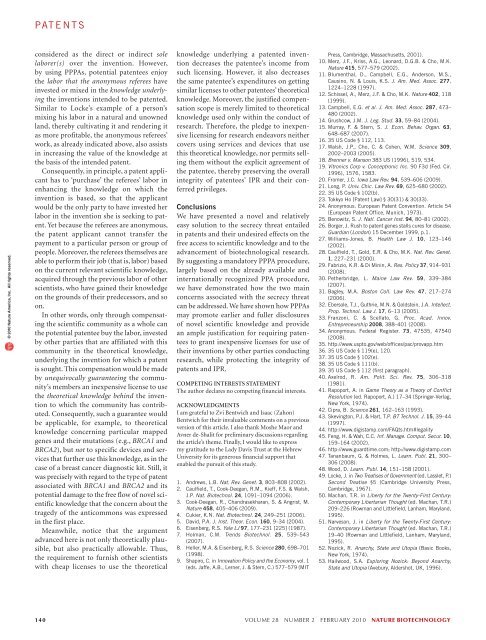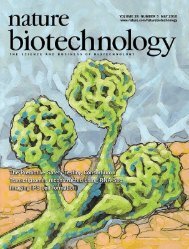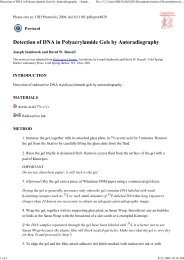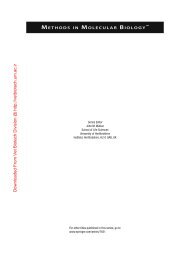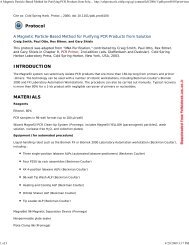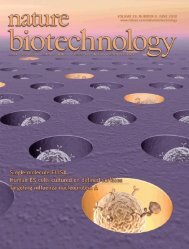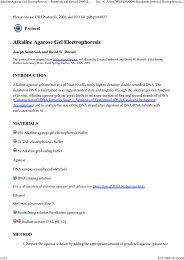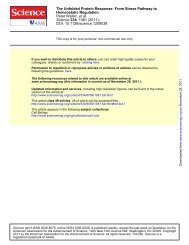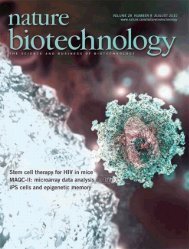Ontology engineering
Ontology engineering
Ontology engineering
You also want an ePaper? Increase the reach of your titles
YUMPU automatically turns print PDFs into web optimized ePapers that Google loves.
patents© 2010 Nature America, Inc. All rights reserved.considered as the direct or indirect solelaborer(s) over the invention. However,by using PPPAs, potential patentees enjoythe labor that the anonymous referees haveinvested or mixed in the knowledge underlyingthe inventions intended to be patented.Similar to Locke’s example of a person’smixing his labor in a natural and unownedland, thereby cultivating it and rendering itas more profitable, the anonymous referees’work, as already indicated above, also assistsin increasing the value of the knowledge atthe basis of the intended patent.Consequently, in principle, a patent applicanthas to ‘purchase’ the referees’ labor inenhancing the knowledge on which theinvention is based, so that the applicantwould be the only party to have invested herlabor in the invention she is seeking to patent.Yet because the referees are anonymous,the patent applicant cannot transfer thepayment to a particular person or group ofpeople. Moreover, the referees themselves areable to perform their job (that is, labor) basedon the current relevant scientific knowledge,acquired through the previous labor of otherscientists, who have gained their knowledgeon the grounds of their predecessors, and soon.In other words, only through compensatingthe scientific community as a whole canthe potential patentee buy the labor, investedby other parties that are affiliated with thiscommunity in the theoretical knowledge,underlying the invention for which a patentis sought. This compensation would be madeby unequivocally guaranteeing the community’smembers an inexpensive license to usethe theoretical knowledge behind the inventionto which the community has contributed.Consequently, such a guarantee wouldbe applicable, for example, to theoreticalknowledge concerning particular mappedgenes and their mutations (e.g., BRCA1 andBRCA2), but not to specific devices and servicesthat further use this knowledge, as in thecase of a breast cancer diagnostic kit. Still, itwas precisely with regard to the type of patentassociated with BRCA1 and BRCA2 and itspotential damage to the free flow of novel scientificknowledge that the concern about thetragedy of the anticommons was expressedin the first place.Meanwhile, notice that the argumentadvanced here is not only theoretically plausible,but also practically allowable. Thus,the requirement to furnish other scientistswith cheap licenses to use the theoreticalknowledge underlying a patented inventiondecreases the patentee’s income fromsuch licensing. However, it also decreasesthe same patentee’s expenditures on gettingsimilar licenses to other patentees’ theoreticalknowledge. Moreover, the justified compensationscope is merely limited to theoreticalknowledge used only within the conduct ofresearch. Therefore, the pledge to inexpensivelicensing for research endeavors neithercovers using services and devices that usethis theoretical knowledge, nor permits sellingthem without the explicit agreement ofthe patentee, thereby preserving the overallintegrity of patentees’ IPR and their conferredprivileges.ConclusionsWe have presented a novel and relativelyeasy solution to the secrecy threat entailedin patents and their undesired effects on thefree access to scientific knowledge and to theadvancement of biotechnological research.By suggesting a mandatory PPPA procedure,largely based on the already available andinternationally recognized PPA procedure,we have demonstrated how the two mainconcerns associated with the secrecy threatcan be addressed. We have shown how PPPAsmay promote earlier and fuller disclosuresof novel scientific knowledge and providean ample justification for requiring patenteesto grant inexpensive licenses for use oftheir inventions by other parties conductingresearch, while protecting the integrity ofpatents and IPR.COMPETING INTERESTS STATEMENTThe author declares no competing financial interests.ACKNOWLEDGMENTSI am grateful to Zvi Bentwich and Isaac (Zahon)Bentwich for their invaluable comments on a previousversion of this article. I also thank Moshe Maor andAvner de-Shalit for preliminary discussions regardingthe article’s theme. Finally, I would like to expressmy gratitude to the Lady Davis Trust at the HebrewUniversity for its generous financial support thatenabled the pursuit of this study.1. Andrews, L.B. Nat. Rev. Genet. 3, 803–808 (2002).2. Caulfield, T., Cook-Deegan, R.M., Kieff, F.S. & Walsh,J.P. Nat. Biotechnol. 24, 1091–1094 (2006).3. Cook-Deegan, R., Chandrasekharan, S. & Angrist, M.Nature 458, 405–406 (2009).4. Cukier, K.N. Nat. Biotechnol. 24, 249–251 (2006).5. David, P.A. J. Inst. Theor. Econ. 160, 9–34 (2004).6. Eisenberg, R.S. Yale LJ 97, 177–231 [225] (1987).7. Holman, C.M. Trends Biotechnol. 25, 539–543(2007).8. Heller, M.A. & Eisenberg, R.S. Science 280, 698–701(1998).9. Shapiro, C. in Innovation Policy and the Economy, vol. 1(eds. Jaffe, A.B., Lerner, J. & Stern, C.) 577–579 (MITPress, Cambridge, Massachusetts, 2001).10. Merz, J.F., Kriss, A.G., Leonard, D.G.B. & Cho, M.K.Nature 415, 577–579 (2002).11. Blumenthal, D., Campbell, E.G., Anderson, M.S.,Causino, N. & Louis, K.S. J. Am. Med. Assoc. 277,1224–1228 (1997).12. Schissel, A., Merz, J.F. & Cho, M.K. Nature 402, 118(1999).13. Campbell, E.G. et al. J. Am. Med. Assoc. 287, 473–480 (2002).14. Grushcow, J.M. J. Leg. Stud. 33, 59–84 (2004).15. Murray, F. & Stern, S. J. Econ. Behav. Organ. 63,648–687 (2007).16. 35 US Code § 112, 113.17. Walsh, J.P., Cho, C. & Cohen, W.M. Science 309,2002–2003 (2005).18. Brenner v. Manson 383 US (1996), 519, 534.19. Vitronics Corp v. Conceptronic Inc. 90 F3d (Fed. Cir.1996), 1576, 1583.20. Fromer, J.C. Iowa Law Rev. 94, 539–606 (2009).21. Long, P. Univ. Chic. Law Rev. 69, 625–680 (2002).22. 35 US Code § 102(b).23. Tokkyo Ho [Patent Law] § 30(31) & 30(33).24. Anonymous. European Patent Convention. Article 54(European Patent Office, Munich, 1973).25. Benowitz, S. J. Natl. Cancer Inst. 94, 80–81 (2002).26. Borger, J. Rush to patent genes stalls cures for disease.Guardian (London) 15 December 1999, p.1.27. Williams-Jones, B. Health Law J. 10, 123–146(2002).28. Caulfield, T., Gold, E.R. & Cho, M.K. Nat. Rev. Genet.1, 227–231 (2000).29. Fabrizio, K.R. & Di Minin, A. Res. Policy 37, 914–931(2008).30. Petherbridge, L. Maine Law Rev. 59, 339–384(2007).31. Bagley, M.A. Boston Coll. Law Rev. 47, 217–274(2006).32. Ebersole, T.J., Guthrie, M.N. & Goldstein, J.A. Intellect.Prop. Technol. Law J. 17, 6–13 (2005).33. Franzoni, C. & Scellato, G. Proc. Acad. Innov.Entrepreneurship 2008, 388–401 (2008).34. Anonymous. Federal Register. 73, 47535, 47540(2008).35. http://www.uspto.gov/web/offices/pac/provapp.htm36. 35 US Code § 119(e), 120.37. 35 US Code § 102(e).38. 35 US Code § 111(b).39. 35 US Code § 112 (first paragraph).40. Axelrod, R. Am. Polit. Sci. Rev. 75, 306–318(1981).41. Rapoport, A. in Game Theory as a Theory of ConflictResolution (ed. Rapoport, A.) 17–34 (Springer-Verlag,New York, 1974).42. Cipra, B. Science 261, 162–163 (1993).43. Skevington, P.J. & Hart, T.P. BT Technol. J. 15, 39–44(1997).44. http://www.digistamp.com/FAQts.htm#legality45. Feng, H. & Wah, C.C. Inf. Manage. Comput. Secur. 10,159–164 (2002).46. http://www.guardtime.com; http://www.digistamp.com47. Tananbaum, G. & Holmes, L. Learn. Publ. 21, 300–306 (2008).48. Wood, D. Learn. Publ. 14, 151–158 (2001).49. Locke, J. in Two Treatises of Government (ed. Lasslet, P.)Second Treatise §5 (Cambridge University Press,Cambridge, 1967).50. Machan, T.R. in Liberty for the Twenty-First Century:Contemporary Libertarian Thought (ed. Machan, T.R.)209–226 (Rowman and Littlefield, Lanham, Maryland,1995).51. Narveson, J. in Liberty for the Twenty-First Century:Contemporary Libertarian Thought (ed. Machan, T.R.)19–40 (Rowman and Littlefield, Lanham, Maryland,1995).52. Nozick, R. Anarchy, State and Utopia (Basic Books,New York, 1974).53. Hailwood, S.A. Exploring Nozick: Beyond Anarchy,State and Utopia (Avebury, Aldershot, UK, 1996).140 volume 28 number 2 february 2010 nature biotechnology


